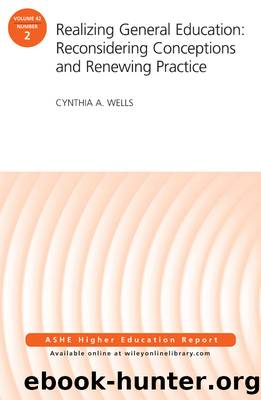Realizing General Education by Cynthia A. Wells

Author:Cynthia A. Wells [Wells, Cynthia A.]
Language: eng
Format: epub
ISBN: 9781119244677
Publisher: Wiley
Published: 2015-12-22T00:00:00+00:00
Competency-Framed2
A third conceptual model of general education focuses on individual abilities and skills of learning and personal growth (Allen, 2006). The model involves a specially created set of general education objectives. A key distinction is that general education models that are framed around competency development focus on process rather than specific content (Katz, 2005).
Stanford University illustrates a general education model that centers on competency development. Stanford's requirements help students âdevelop a broad set of essential intellectual and social competencies that will be of enduring valueâ regardless of specific field of study (Stanford University, n.d.). General education requirements introduce students to the âintellectual life of the Universityâ and serve âto foreground important questions and to illustrate how they may be approached from multiple perspectives.â
Stanford students are required to take a specified number of courses within each of four areas of the general education curriculum: Thinking Matters, Ways of Thinking/Ways of Doing (WAYS), Writing and Rhetoric, and Foreign Language. The foundation of the Stanford general education curriculum is the Thinking Matters requirement for which the âmain goal is to help students develop the ability to ask rigorous and genuine questions that can lead to scientific experimentation or literary interpretation or social policy analysis.â Most Stanford students fulfill this requirement by taking a stand-alone, designated Thinking Matters seminar during their first year.
The WAYS requirement provides instruction in essential skills and capacities in the areas of aesthetic and interpretive inquiry, social inquiry, scientific method and analysis, formal reasoning, applied quantitative reasoning, engaging diversity, ethical reasoning, and creative expression. Students are required to take 11 certified WAYS courses, and are permitted to overlap general education courses as well as major requirements to meet this requirement.
Students also complete a Writing and Rhetoric requirement that is intended to develop their âabilities in analysis, academic argument, and research-based writing and oral presentation.â One Writing and Rhetoric course is taken in the first year, a second in the sophomore year, and a third in the major. Finally, students have a Foreign Language requirement in which they must complete 1 year of college-level study in a foreign language.
The competency model of general education has a variety of benefits. Arguably, specific skills and abilities being advanced by general education are less controversial than specific content or academic disciplines. It would be rare to hear anyone suggest that strong writing or critical thinking is an unimportant component of a general education. Another benefit is the ability to overlap fluidly if not seamlessly with requirements in the major.
Some of the challenges of the competency development model of general education revolve around what then makes general education courses distinct or necessary beyond the major. After all, major requirements surely include writing and critical thinking. Another challenge, although not unique to this delivery model of general education, is that writing skills and critical thinking skills break down into a variety of subskills. Achieving consensus on where and by whom these are addressed in the curriculum can be a challenge. For example, if writing skills are
Download
This site does not store any files on its server. We only index and link to content provided by other sites. Please contact the content providers to delete copyright contents if any and email us, we'll remove relevant links or contents immediately.
| Administration | Adult & Continuing Education |
| Business School Guides | College Guides |
| Financial Aid | Graduate School Guides |
| Law School Guides | Medical School Guides |
| Test Preparation | Vocational |
Spare by Prince Harry The Duke of Sussex(5138)
Navigation and Map Reading by K Andrew(5133)
Tuesdays with Morrie by Mitch Albom(4727)
Machine Learning at Scale with H2O by Gregory Keys | David Whiting(4258)
Cracking the GRE Premium Edition with 6 Practice Tests, 2015 (Graduate School Test Preparation) by Princeton Review(4248)
Never by Ken Follett(3879)
Goodbye Paradise(3761)
What It Really Takes to Get Into Ivy League and Other Highly Selective Colleges by Hughes Chuck(3715)
Harry Potter and the Prisoner of Azkaban (Book 3) by J. K. Rowling(3323)
Fairy Tale by Stephen King(3307)
Pledged by Alexandra Robbins(3152)
Kick Ass in College: Highest Rated "How to Study in College" Book | 77 Ninja Study Skills Tips and Career Strategies | Motivational for College Students: A Guerrilla Guide to College Success by Fox Gunnar(3095)
A Dictionary of Sociology by Unknown(3044)
Sapiens and Homo Deus by Yuval Noah Harari(3028)
Reminders of Him: A Novel by Colleen Hoover(3010)
The Social Psychology of Inequality by Unknown(2987)
Graduate Admissions Essays, Fourth Edition: Write Your Way into the Graduate School of Your Choice (Graduate Admissions Essays: Write Your Way Into the) by Asher Donald(2890)
Will by Will Smith(2872)
Zero to Make by David Lang(2753)
